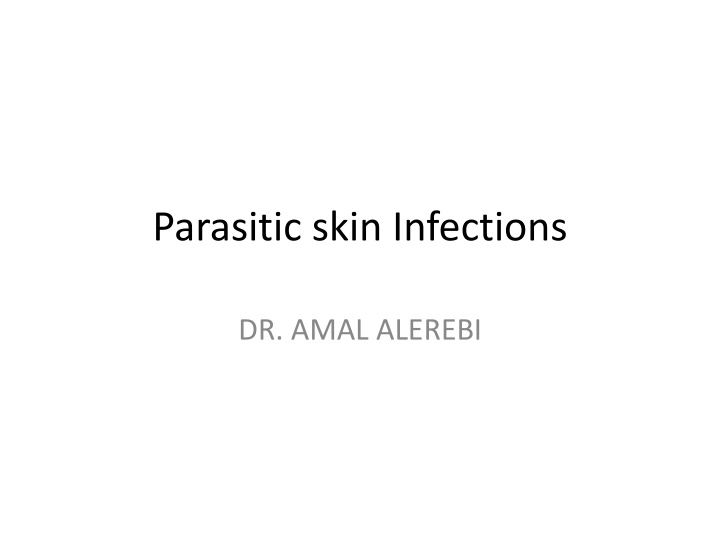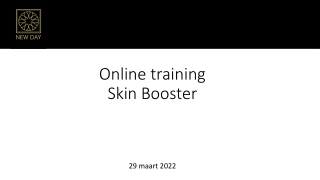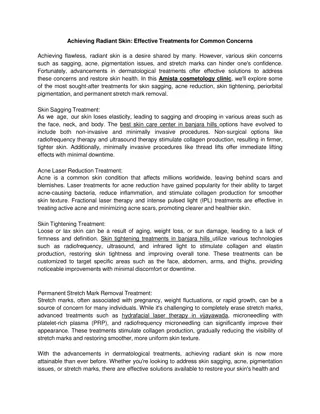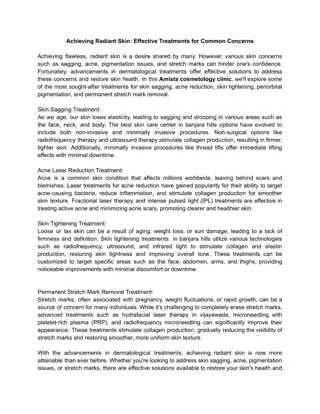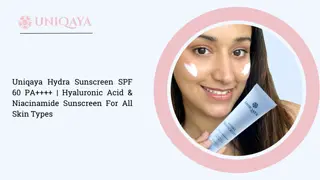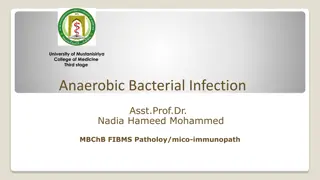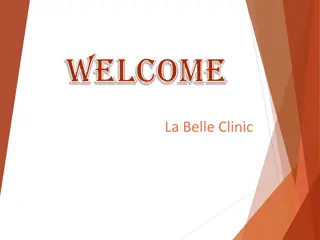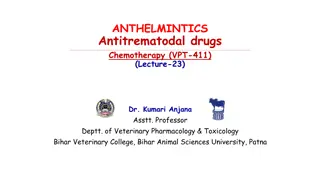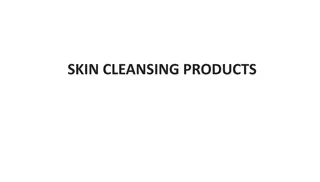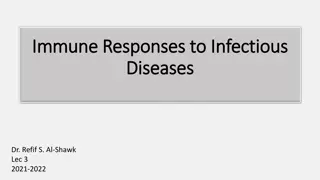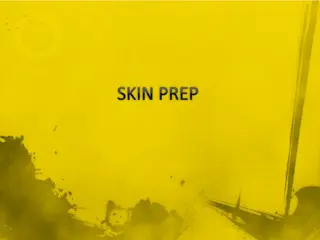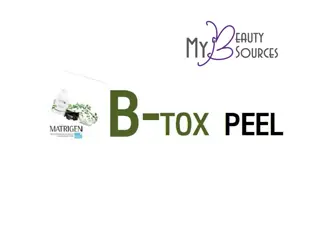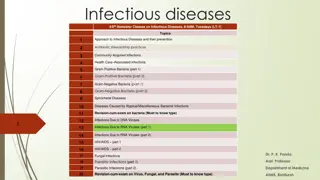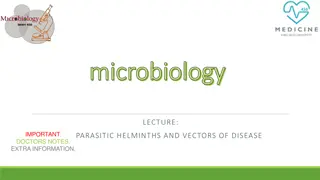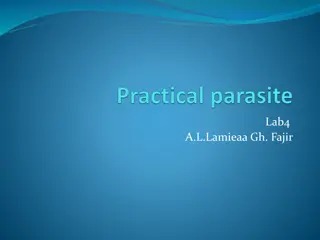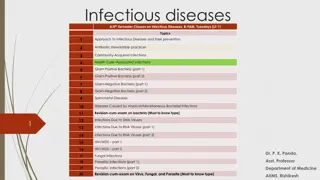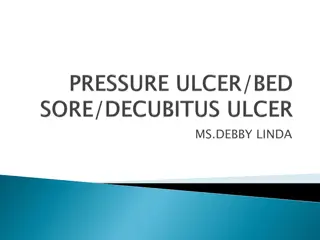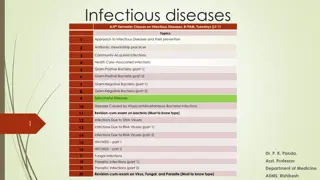Parasitic Skin Infections: Scabies Overview and Treatment
Parasitic skin infections, such as scabies, are common and contagious infestations caused by mites. Learn about the clinical features, transmission, and treatment options for scabies, including scabicidal preparations and management techniques.
Download Presentation

Please find below an Image/Link to download the presentation.
The content on the website is provided AS IS for your information and personal use only. It may not be sold, licensed, or shared on other websites without obtaining consent from the author.If you encounter any issues during the download, it is possible that the publisher has removed the file from their server.
You are allowed to download the files provided on this website for personal or commercial use, subject to the condition that they are used lawfully. All files are the property of their respective owners.
The content on the website is provided AS IS for your information and personal use only. It may not be sold, licensed, or shared on other websites without obtaining consent from the author.
E N D
Presentation Transcript
Parasitic skin Infections DR. AMAL ALEREBI
The parasitic skin diseases include: Scabies Pediculosis Leishmaniasis
Scabies Scabies is a common contagious infestation Caused by a mite Sarcoptes scabiei. Average 12 mites . Scabies affect all races , any ages , both sexes
Transmission Direct skin-to-skin contact Sexually Indirect-clothing or bedding
Clinical features Characterized by generalized itching (Nocturnal itching ) I.P: 3 - 4 weeks Sites: fingers webs, anterior axillary fold, periumblical area, buttocks. In adult male penis and scrotum In women . Aerolae In infants .. face, palms and soles Lesions: papules, vesicles, pustules, scratch marks, eczematous lesions and burrows ( pathgnomonic lesion).
Clinical variants of scabies Crusted (norwegain)scabies: Nodular scabies Scabies in clean
Treatment All close contacts should be treated at the same time Application of treatment should cover all skin sites Bedding ,clothing and towles should be decontaminted by machine washing at 60c The scabicidal preparation should be applied after bathing(Except lindane)
Scabicidal preparation 1. Precipitated sulfur ( 5% - 10%). Topically overnight treatment, for 3 days. 2. Benzyle Benzoate (10% - 25%). Topically overnight treatment, for 3 days 3. Gamma Benzene Hexachloride 1%. Overnight treatment; on days 1 and day 8 4. Permethrin 5% . Topically overnight treatment; on days 1 and on day 8 5. Malathion 0.5% Topically overnight treatment; on days 1 and on day 8. 6. Crotamiton 10% ( Weak scabicidal ). Overnight, on days 1, 2, 3 and on day 8 7. Systemic ivermectin 200microg/kg single dose. Orally on day 1 and on day 14.
Pediculosis infestation with lice Pediculosis capitis . P. Humanus capitis Pediculosis corporis p.humanus corporis Pediculosis Pubis .phthirus pubis
Head louse Body louse
Pediculosis capitis Infestation of the scalp by the head louse Affects all ages sex races Common in children 3-11y ( girls longer hair ) Transmission: direct head to head contact Indirect :combs bedding ..etc
Life Cycle Eggs(nits) 5 10 eggs/day 1 2 days About 10 days Nymph About 10 days Adult Louse Life span 1 month 20
Clinical features Any where on the scalp , occipital & post auricular region . Scalp itching is characteristic Identification of nits and lice on the scalp hair Secondary bacterial infection pustules, crusting, cervical LAP
Treatment All close contacts should be treated at the same time All pediculicides are effective against lice but not against nits except malathion Gamma Benzene Hexachloride 1% (Lindane) Permethrin 1% Melathion 0.5% Pyrethrins Ivermectin tab
Pediculosis Pubis Pediculosis pubis is caused by Phthirus pubis ( Crab louse). Often considered a STD. Other MOT includes contaminated clothing, towels or bedding. Pubic hair is the most common site of infestation. May involve other hair-bearing sites e.g upper thighs, axillae, chest, or beard. Majority of pt. complain of pruritus & aware that something is crawling on the groin. Maculae ceruleae: Gray-blue macules varying in size, (0.5cm- 1cm) seen in groin, upper thigh, and lower trunk. They are seen in chronic infestations and represent altered blood pigment. Shaving the pubic hair plus application of one of pediculicidales preparation is curative.
Pediculosis corporis Caused by Pediculus humanus var. corporis. Associated with overcrowding, poor hygiene, wars and natural disasters. The lice live and lay their nits in the seams of clothing They visit the skin surface only to feed. Body lice induce pruritus that leads to scratching and secondary infection. The back, neck, shoulders and waist areas are commonly involved sites. Diagnosis i by demonstration of nits and/or adult lice in the clothes seams. Ironing the clothes will destroy the lice as well as the nits. Plus one of pediculicidales preparation applied to the patient is curative.
Leishmaniasis Parasitc infection caused a protozoa Leishmania charateraizd clinically by single/multiple papules at the site of sandfly bite that evolve into nodule which ulcerate and eventually heals with scarring
Classification of Leishmaniasis 1. Cutaneous Leishmaniasis 2. Mucocutaneous Leishmaniasis. 3. Visral Leishmaniasis
Promastigote Amastigote In Sandfly promastigote Spindle shaped. Flagellated. 10 -15 microm. Sandfly GIT. In Human Amastigote. Oval / Round. Aflagellated. 2 3 micom. Cells of RES. 29
Epidemiology Worldwide, 400.000 new cases annually. Over 90% of cutaneous leishmaniasis occur in Afghanistan, Iran, Saudi Arabia, Syria, Also seen in the Mediterranean basin. The reservoirs are canine and rodent. Any age and both sexes are equally affected. 31
Cutaneous Leishmaniasis OWCL NWCL Urban Rural L. tropica. >2 months. Dry nodules. Heal < 6months L. major. 2 4 weeks. Wet nodule. Heals >6 months 32
Differential Diagnosis Impetigo Furuncle Carbuncle Ecthyma Kerion keratoacathoma
Diagnosis 1) Skin Slit and Smear (SSS). The cytoplasm appears blue , the nucleus pink and the kinetoplast a deep red. 2) Culture : On Nicolle Novy MacNeal (NNM) media or chick embryo media. Cultures are positive in approximately 40% of cases. 3) Serologic Testing: PCR which when available represents the most sensitive diagnostic test. 4) Montenegro Skin Test ( Leishmanin intradermal test) : An important diagnostic tool in non-endemic area. The test is positive in up to 90% of patients. It cannot distinguish between past and present infections
Amastigote Amastigote. Oval / Round. Aflagellated. 2 3 micom. Cells of RES.
Treatment LOCAL THERAPY CRYOTHERAPY ELECTRIC CAUTRY. PENTOSTAM. SYSTEMIC THERAPY Na. STIBOGLUCONATE AMOPHOTERICIN B RIFAMPICINE ITRACONAZOLE
